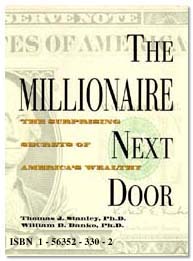

University at Albany professor, William D. Danko, and Atlanta researcher and consultant, Thomas J. Stanley hit New York Times best seller list.

Many people ask this question of themselves all the time. Often they are hard-working, well-educated, middle- to high-income people. Why, then, are so few affluent? The answer lies in The Millionaire Next Door: The Surprising Secrets of America's Wealthy.
This is the never-before-unearthed story about America's rich--and how they got that way. According to authors Thomas J. Stanley and William D. Danko, most people have it all wrong about how you become wealthy in America. It is seldom inheritance or advanced degrees or even intelligence that builds fortunes in this country. Wealth in America is more often the result of hard work, diligent savings, and living below your means. The Millionaire Next Door will tell you the seven common denominators that show up again and again among those who have accumulated wealth.
You will learn, for instance, that many millionaires bargain shop for used cars, pay a tiny fraction of their wealth in income tax, raise children who are often unaware of their family's wealth until they are adults, and, above all, reject the big-spending lifestyles most of us associate with rich people. In fact, you will learn that the flashy millionaires glamorized by the media actually represent only a tiny minority of America's rich. Most of the truly wealthy in this country don't live in Beverly Hills or on Park Avenue--they live next door.
Stanley and Danko have been studying the wealthy in this country for 20 years. Using their two decades' worth of surveys, interviews, and data available nowhere else, they have compiled a detailed picture of who the rich are and how they live that will change forever your perception of what being wealthy really means.
Albany Times Union article, Sunday, January 26, 1997
University Update article, Volume 20, Number 5, October 30, 1996